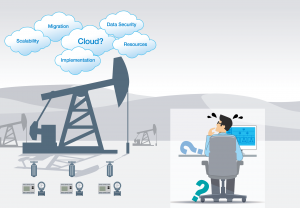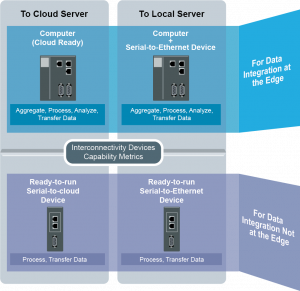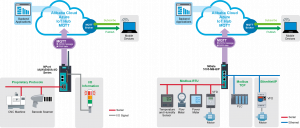
How to Connect Serial Devices to the IIoT Through the Cloud
“Originally, we began to collect data from wellhead applications to understand production output. Now, my manager wants me to collect more data from field-site sensors such as RTU or meters to build an application to increase OEE. So I am thinking whether it would be more effective to send the field data to the cloud and analyse it through cloud systems?” These lines of thought about cloud connectivity are becoming now more and more commonplace in all types of industries as the benefits of the Industrial Internet of Things (IIoT) cannot be ignored by managers anymore. However, before implementing cloud systems into IIoT applications, several factors need your consideration. In this article, Moxa points out what you need to verify before you decide whether it is necessary to store your data in cloud systems. And, if you do decide to go cloudwards, Moxa can help you choose the best-fit devices to connect your field devices to the cloud.

Should I Store Field Data in the Cloud?
The rationale behind IIoT deployment is to collect data from end devices to get actionable insights. But, where do we store these huge amounts of data? As data users, we need to ask ourselves some key questions:
- Are the field devices in my application mostly distributed in various locations?
- Does my organisation have the ability to maintain its own data server, meaning do I have the money and expertise to either keep up the computing power that my application requires or ensure data storage capacity for collected field data?
- Does my application need to be able to access field data from anywhere and anytime?
- Will my application need to be scaled up over time?
If your answers are mostly “Yes” to the above questions, then it is a good idea to get your devices connected to the cloud. So you have made your decision to connect to the cloud. Now, you have to deal with the all-too-familiar problem of choosing interconnectivity devices that meet the requirements of your application.
Choosing Interconnectivity Devices to the Cloud Based on Your Demands
Once you decide to put your field data onto the cloud, the first challenge you will face is that many edge devices do not speak a language that the Internet understands. The ability of interconnectivity devices to connect to the cloud is key should you choose the cloud as your backend data server. In addition to the southbound (supporting protocols for your device) and northbound (supporting cloud connections) capabilities of your network, data integration is another factor that needs to be considered. In some applications, data analysis or network integration tasks may take place on the edge, and in others, it may happen in the cloud. These factors will greatly influence your choice of interconnectivity devices for your IIoT deployment.
The following figure shows the Interconnectivity Devices Capability Metrics, outlining the suggested interconnectivity devices by mapping your data integration needs with the selected backend data server.

For applications where data integration does not need to take place at the edge, a simple ready-to-run serial-to-cloud device can save you a lot of effort and front-end costs.
The Fast Track to Bring Your Serial Devices to the Cloud
Moxa’s ready-to-run serial-to-cloud devices, the NPort IA(W)5000A-I/O Series and MGate 5105-MB-EIP Series, bring multiple types of field data, including serial, I/O, Modbus, and EtherNet/IP, onto different cloud platforms. These devices have built-in SDK for Microsoft Azure and Alibaba Cloud for easy and quick cloud adoption, and they support generic MQTT that connects to Amazon AWS cloud and other private clouds.

Furthermore, Moxa’s device servers and protocol gateways not only offer multiple serial-to-cloud combinations, but are also designed to simplify your device configuration. If you want to learn more about our product information, watch our serial-to-cloud video or visit NPort IA5000A-I/O, NPort IAW5000A-I/O, and MGate 5105-MB-EIP product pages.
Learn More
Moxa has more than 30 years of expertise in connectivity to enable reliable network solutions for customers. Download the complete Insider Guide to learn more details and useful tips on how to enable IIoT connectivity. Visit here to find out more information for Moxa’s simple serial-to-Ethernet solutions.
